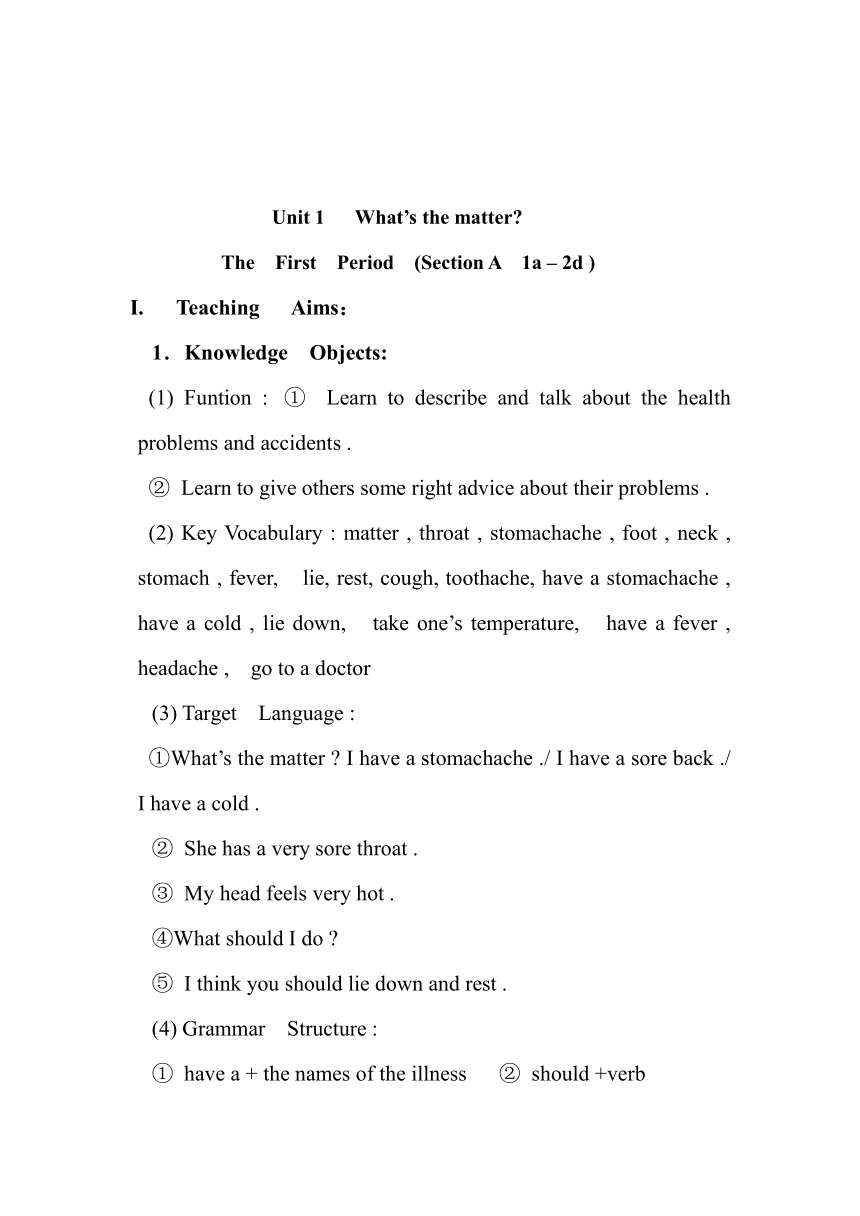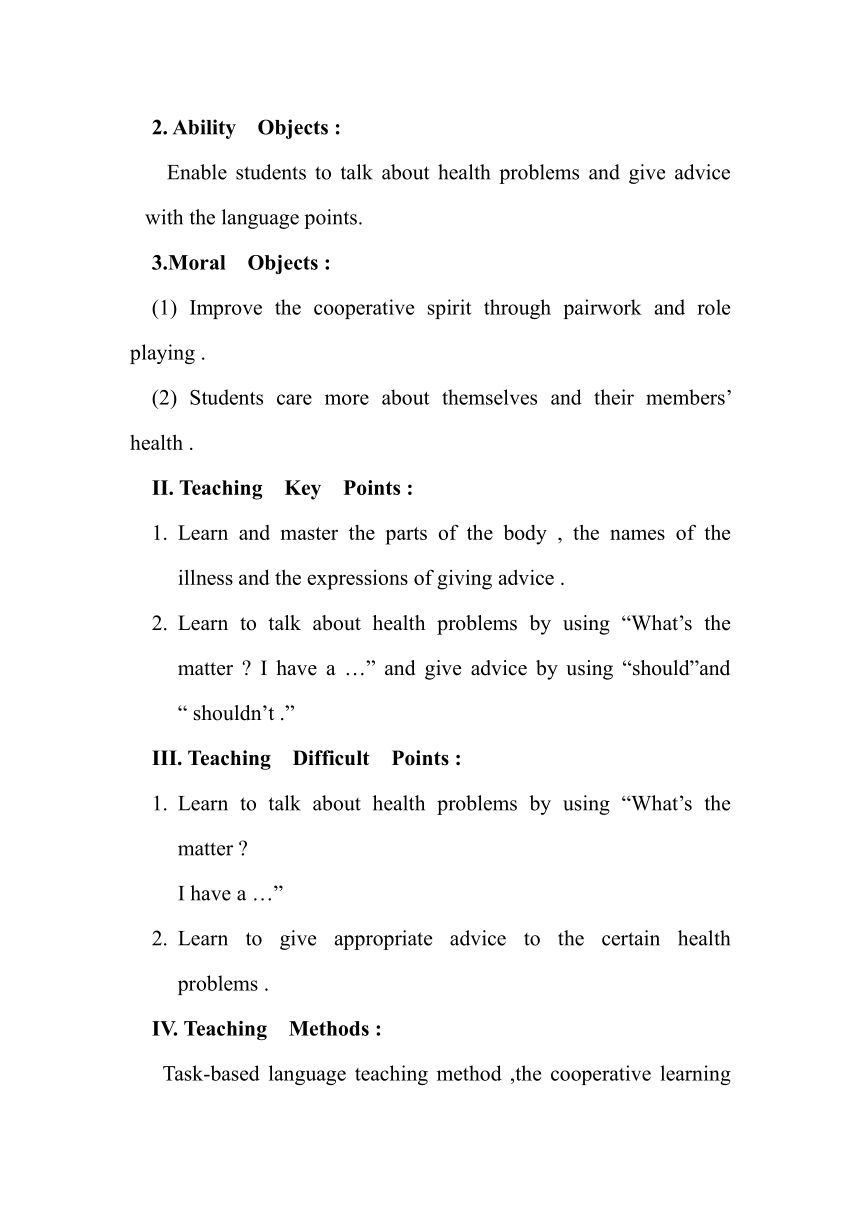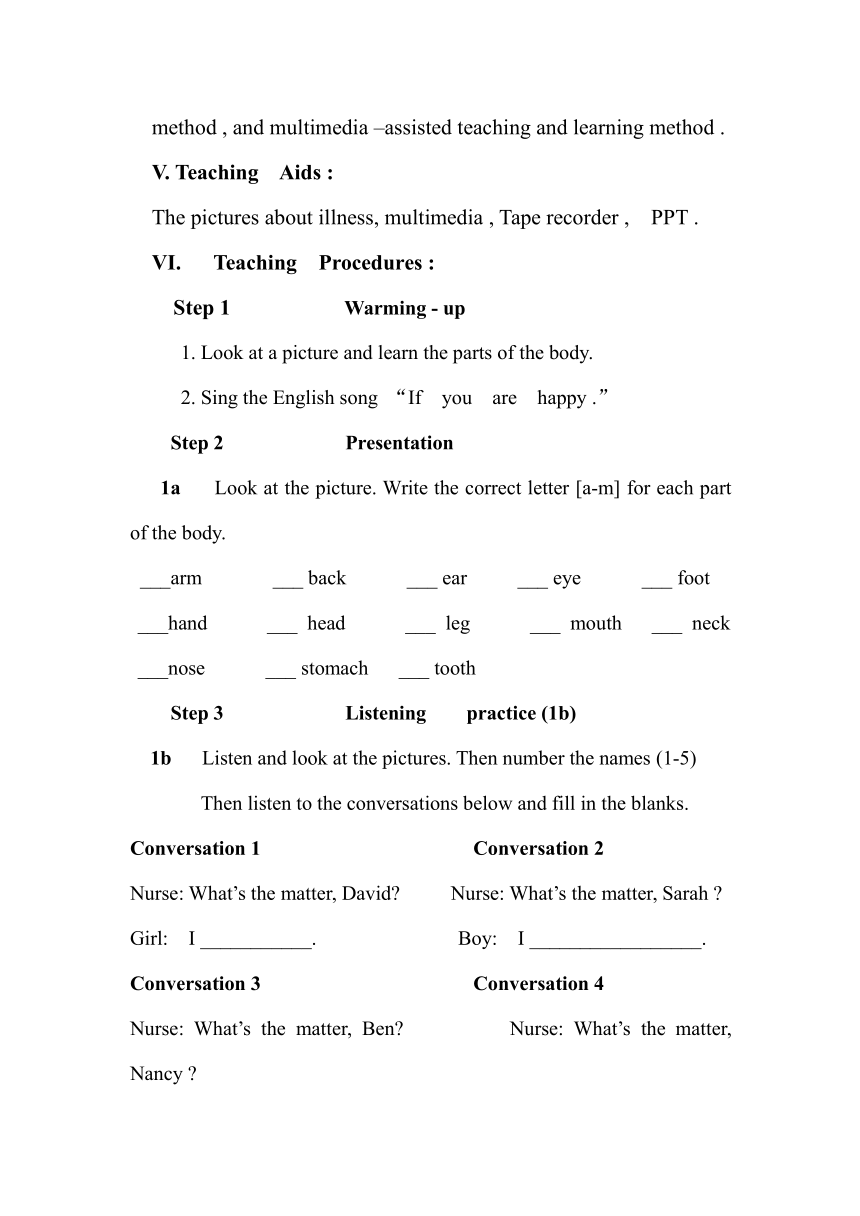Unit 1 What’s the matter? Section A 1a – 2d 教案(含教学反思)
文档属性
| 名称 | Unit 1 What’s the matter? Section A 1a – 2d 教案(含教学反思) |  | |
| 格式 | docx | ||
| 文件大小 | 19.4KB | ||
| 资源类型 | 教案 | ||
| 版本资源 | 人教新目标(Go for it)版 | ||
| 科目 | 英语 | ||
| 更新时间 | 2022-03-25 16:28:26 | ||
图片预览



文档简介
Unit 1 What’s the matter
The First Period (Section A 1a – 2d )
I. Teaching Aims:
1.Knowledge Objects:
(1) Funtion : ① Learn to describe and talk about the health problems and accidents .
② Learn to give others some right advice about their problems .
(2) Key Vocabulary : matter , throat , stomachache , foot , neck , stomach , fever, lie, rest, cough, toothache, have a stomachache , have a cold , lie down, take one’s temperature, have a fever , headache , go to a doctor
(3) Target Language :
①What’s the matter I have a stomachache ./ I have a sore back ./ I have a cold .
② She has a very sore throat .
③ My head feels very hot .
④What should I do
⑤ I think you should lie down and rest .
(4) Grammar Structure :
① have a + the names of the illness ② should +verb
2. Ability Objects :
Enable students to talk about health problems and give advice with the language points.
3.Moral Objects :
(1) Improve the cooperative spirit through pairwork and role playing .
(2) Students care more about themselves and their members’ health .
II. Teaching Key Points :
Learn and master the parts of the body , the names of the illness and the expressions of giving advice .
Learn to talk about health problems by using “What’s the matter I have a …” and give advice by using “should”and “ shouldn’t .”
III. Teaching Difficult Points :
Learn to talk about health problems by using “What’s the matter
I have a …”
Learn to give appropriate advice to the certain health problems .
IV. Teaching Methods :
Task-based language teaching method ,the cooperative learning method , and multimedia –assisted teaching and learning method .
V. Teaching Aids :
The pictures about illness, multimedia , Tape recorder , PPT .
VI. Teaching Procedures :
Step 1 Warming - up
1. Look at a picture and learn the parts of the body.
2. Sing the English song “If you are happy .”
Step 2 Presentation
1a Look at the picture. Write the correct letter [a-m] for each part of the body.
___arm ___ back ___ ear ___ eye ___ foot
___hand ___ head ___ leg ___ mouth ___ neck ___nose ___ stomach ___ tooth
Step 3 Listening practice (1b)
1b Listen and look at the pictures. Then number the names (1-5)
Then listen to the conversations below and fill in the blanks.
Conversation 1 Conversation 2
Nurse: What’s the matter, David Nurse: What’s the matter, Sarah
Girl: I ___________. Boy: I _________________.
Conversation 3 Conversation 4
Nurse: What’s the matter, Ben Nurse: What’s the matter, Nancy
Boy: I _________________. Girl: I ___________.
Step 4 Pairwork (1c)
1c First look at the pictures. What are the students’ problems Make conversations like this :
A: What’s the matter with Judy
B: She talked too much yesterday and didn’t drink enough water.
She has a very sore throat now.
Then ask the students to make the similar conversations according to the illness in the picture in pairs.
Step 5 Guessing games
Ask some students to the front of the classroom, and show their expressions and activities. Ask the other students to guess what’s the matter with the students.
Step 6 Listening (2a-2b)
2a Listen and number the pictures [1-5] in the order you hear them.
2b Listen again. Match the problems with the advice.
1. fever a. lie down and rest
2. stomachache b. drink some hot tea
3. cough and sore throat c. see a dentist and get an X-ray
4. toothache d. take your temperature
5. cut myself e. put some medicine on it
Step 7 pairwork (2c)
2c First ask the students to read the conversations below :
A: What’s the matter
B: My head feels very hot.
A: Maybe you have a fever.
B: What should I do
A: You should take your temperature .
Then ask them to make conversations using the information in 2a and 2b in pairs .
. Step 8 Role –play (2d)
1. Imagine you are a school doctor. A few students have health problems. practice a conversation between the doctor and the students.Then ask the students to role –play the conversation 2d .
2. Answer the questions.
1) What’s the matter with Lisa
2) Did she have a fever
3) What does she need to do
4) What should she do for now
Step 9 Summary
Ask students to sum up the parts of a body and the names of illness .
Help students to sum up how to give advice by using “should”and “shouldn’t”.
Step 10 Exercises
Ⅰ. 根据语境及提示,补全所缺单词。
1. There’s something wrong with his two f and he can’t walk.
2. —How about r under the tree
—That’s a good idea. I’m also tired.
3. I have a t and I think I must see the dentist.
Ⅱ. 根据语境及所给单词的提示填空。
1. I think giraffes have the longest ________ (neck) in the world.
2. Emma ________ (hurt) her back when she fell off her horse.
3. Bill didn’t finish the work because he had a terrible ________ (head).
4. —Cindy, you didn’t sleep well
—Yes, I ________ (cough) all night long.
5. My father’s ___________ (stomach) stopped after he took the medicine.
Ⅲ. 根据句意及提示,用恰当的短语填空。
1. When you ___________ (感冒), food has very little flavor (味道) to you.
2. __________ (躺下) on your bed and make yourself comfortable.
3. You shouldn’t go outside, for you still ___________ (发烧).
4. We have walked for two hours. Can we ____________ (休息)
5. It sounds like you’re coming down with the flu. Let me ______________________ (量体温).
Step 11 Homework
Ask students to make up a conversation between a doctor and a patient.
VII. 教学反思:
本节课在教学中注意利用图片和动作,从感官上刺激学生,能很快地抓住学生的注意力,再通过学生小组表演,给学生充分表现自己的机会,充分体现学生在教学中的主体地位。并结合医生和病人的游戏,巩固知识,同时训练了学生的协作能力,并通过给病人提出合理建议,让学生充满成就感。
多媒体辅助教学可以提高课堂教学容量,调动学生多个感官对知识的感知,实现信息传递的多渠道化,但呈现速度还有待调节。
本节课各环节联系较紧密,但时间分配上应做稍微调节,教师应该注意学生的课堂反应,把握教学节奏。
The First Period (Section A 1a – 2d )
I. Teaching Aims:
1.Knowledge Objects:
(1) Funtion : ① Learn to describe and talk about the health problems and accidents .
② Learn to give others some right advice about their problems .
(2) Key Vocabulary : matter , throat , stomachache , foot , neck , stomach , fever, lie, rest, cough, toothache, have a stomachache , have a cold , lie down, take one’s temperature, have a fever , headache , go to a doctor
(3) Target Language :
①What’s the matter I have a stomachache ./ I have a sore back ./ I have a cold .
② She has a very sore throat .
③ My head feels very hot .
④What should I do
⑤ I think you should lie down and rest .
(4) Grammar Structure :
① have a + the names of the illness ② should +verb
2. Ability Objects :
Enable students to talk about health problems and give advice with the language points.
3.Moral Objects :
(1) Improve the cooperative spirit through pairwork and role playing .
(2) Students care more about themselves and their members’ health .
II. Teaching Key Points :
Learn and master the parts of the body , the names of the illness and the expressions of giving advice .
Learn to talk about health problems by using “What’s the matter I have a …” and give advice by using “should”and “ shouldn’t .”
III. Teaching Difficult Points :
Learn to talk about health problems by using “What’s the matter
I have a …”
Learn to give appropriate advice to the certain health problems .
IV. Teaching Methods :
Task-based language teaching method ,the cooperative learning method , and multimedia –assisted teaching and learning method .
V. Teaching Aids :
The pictures about illness, multimedia , Tape recorder , PPT .
VI. Teaching Procedures :
Step 1 Warming - up
1. Look at a picture and learn the parts of the body.
2. Sing the English song “If you are happy .”
Step 2 Presentation
1a Look at the picture. Write the correct letter [a-m] for each part of the body.
___arm ___ back ___ ear ___ eye ___ foot
___hand ___ head ___ leg ___ mouth ___ neck ___nose ___ stomach ___ tooth
Step 3 Listening practice (1b)
1b Listen and look at the pictures. Then number the names (1-5)
Then listen to the conversations below and fill in the blanks.
Conversation 1 Conversation 2
Nurse: What’s the matter, David Nurse: What’s the matter, Sarah
Girl: I ___________. Boy: I _________________.
Conversation 3 Conversation 4
Nurse: What’s the matter, Ben Nurse: What’s the matter, Nancy
Boy: I _________________. Girl: I ___________.
Step 4 Pairwork (1c)
1c First look at the pictures. What are the students’ problems Make conversations like this :
A: What’s the matter with Judy
B: She talked too much yesterday and didn’t drink enough water.
She has a very sore throat now.
Then ask the students to make the similar conversations according to the illness in the picture in pairs.
Step 5 Guessing games
Ask some students to the front of the classroom, and show their expressions and activities. Ask the other students to guess what’s the matter with the students.
Step 6 Listening (2a-2b)
2a Listen and number the pictures [1-5] in the order you hear them.
2b Listen again. Match the problems with the advice.
1. fever a. lie down and rest
2. stomachache b. drink some hot tea
3. cough and sore throat c. see a dentist and get an X-ray
4. toothache d. take your temperature
5. cut myself e. put some medicine on it
Step 7 pairwork (2c)
2c First ask the students to read the conversations below :
A: What’s the matter
B: My head feels very hot.
A: Maybe you have a fever.
B: What should I do
A: You should take your temperature .
Then ask them to make conversations using the information in 2a and 2b in pairs .
. Step 8 Role –play (2d)
1. Imagine you are a school doctor. A few students have health problems. practice a conversation between the doctor and the students.Then ask the students to role –play the conversation 2d .
2. Answer the questions.
1) What’s the matter with Lisa
2) Did she have a fever
3) What does she need to do
4) What should she do for now
Step 9 Summary
Ask students to sum up the parts of a body and the names of illness .
Help students to sum up how to give advice by using “should”and “shouldn’t”.
Step 10 Exercises
Ⅰ. 根据语境及提示,补全所缺单词。
1. There’s something wrong with his two f and he can’t walk.
2. —How about r under the tree
—That’s a good idea. I’m also tired.
3. I have a t and I think I must see the dentist.
Ⅱ. 根据语境及所给单词的提示填空。
1. I think giraffes have the longest ________ (neck) in the world.
2. Emma ________ (hurt) her back when she fell off her horse.
3. Bill didn’t finish the work because he had a terrible ________ (head).
4. —Cindy, you didn’t sleep well
—Yes, I ________ (cough) all night long.
5. My father’s ___________ (stomach) stopped after he took the medicine.
Ⅲ. 根据句意及提示,用恰当的短语填空。
1. When you ___________ (感冒), food has very little flavor (味道) to you.
2. __________ (躺下) on your bed and make yourself comfortable.
3. You shouldn’t go outside, for you still ___________ (发烧).
4. We have walked for two hours. Can we ____________ (休息)
5. It sounds like you’re coming down with the flu. Let me ______________________ (量体温).
Step 11 Homework
Ask students to make up a conversation between a doctor and a patient.
VII. 教学反思:
本节课在教学中注意利用图片和动作,从感官上刺激学生,能很快地抓住学生的注意力,再通过学生小组表演,给学生充分表现自己的机会,充分体现学生在教学中的主体地位。并结合医生和病人的游戏,巩固知识,同时训练了学生的协作能力,并通过给病人提出合理建议,让学生充满成就感。
多媒体辅助教学可以提高课堂教学容量,调动学生多个感官对知识的感知,实现信息传递的多渠道化,但呈现速度还有待调节。
本节课各环节联系较紧密,但时间分配上应做稍微调节,教师应该注意学生的课堂反应,把握教学节奏。
同课章节目录
- Unit 1 What's the matter?
- Section A
- Section B
- Unit 2 I'll help to clean up the city parks.
- Section A
- Section B
- Unit 3 Could you please clean your room?
- Section A
- Section B
- Unit 4 Why don't you talk to your parents?
- Section A
- Section B
- Unit 5 What were you doing when the rainstorm came
- Section A
- Section B
- Review of Units 1-5
- Unit 6 An old man tried to move the mountains.
- Section A
- Section B
- Unit 7 What's the highest mountain in the world?
- Section A
- Section B
- Unit 8 Have you read Treasure Island yet?
- Section A
- Section B
- Unit 9 Have you ever been to a museum?
- Section A
- Section B
- Unit 10 I've had this bike for three years.
- Section A
- Section B
